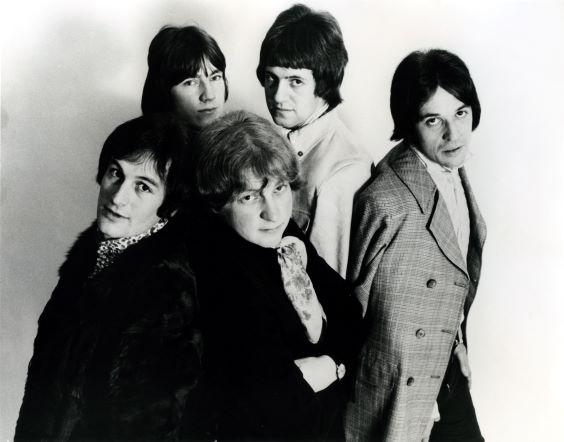
Aficionados of UK freakbeat will be familiar with The Penny Peeps’ Who-inspired rocker “Model Village”, which graced the ‘B’ side of the band’s debut single “Little Man with a Stick” for Liberty Records in February 1968.
With its swirling organ, driving guitar and powerful lead vocal, the track is justifiably revered as a minor ’60s classic and has turned up over the years on a number of compilations, most notably the Rubble series and the box set Acid Drops, Spacedust & Flying Saucers.
Little is known about the Penny Peeps, aside from the fact that they recorded two hopelessly obscure, yet highly collectable singles for Liberty Records, which today can fetch astronomical sums of money.
Collectors may be surprised to learn, however, that The Penny Peeps’ guitarist was none other than future Jethro Tull axe man Martin Barre (b. 17 November 1946, King’s Heath, Birmingham).
Perhaps more surprising is news that The Penny Peeps recorded around 15 demos for the label in early 1968, including the marvellous “Meet Me at the Fair”, the band’s preferred choice as ‘B’ side for “Model Village”. The infectious soul-tinged rocker was subsequently dropped in favour of the more commercial “Little Man with a Stick”.
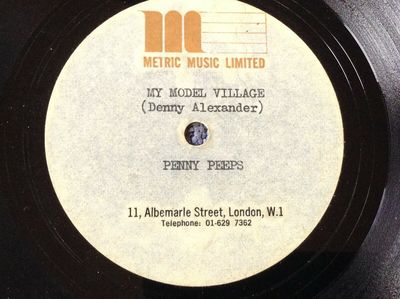
As fate would have it both “Little Man with a Stick” and its follow up single, “I See the Morning” sank without a trace and the group’s lead singer and song-writer, Denny Alexander, departed during August 1968. The group briefly continued as a quartet under the name Gethsemane before the musicians went their separate ways that December.
While Barre subsequently “landed on his feet” joining highly respected blues band, Jethro Tull, the music he recorded with his pre-Tull bands has often been overlooked.
Martin Barre, who’d previously played with Midlands bands The Dwellers and The Moonrakers, had joined the group that would become The Penny Peeps in July 1966.
Known as The Noblemen at the time, the group also comprised singer Jimmy Marsh; guitarist Chuck Fryers; bass player Bryan Stevens (b. 13 November 1941, Lha Datu, North Borneo); keyboard player Mike Ketley (b. 1 October 1947, Balham, London); sax player Chris Rodger; and drummer Malcolm Tomlinson (b. 16 June 1946, Isleworth, Middlesex; d. 2 April 2016).
However, Fryers dropped out soon afterwards (later to join The Sorrows) and after a few months, the band changed name to Motivation (sometimes billed as The Motivation – see earlier entry).
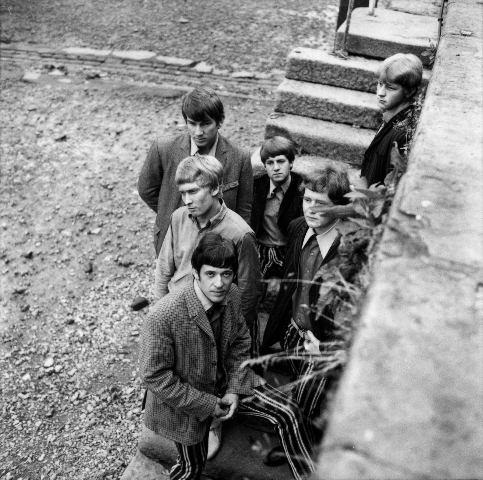
During a trip to Italy in March-May 1967 singer Jimmy Marsh departed followed soon after by sax player Chris Rodger when the group returned home. With Ketley handling lead vocals in the short-term, the band started to look for a new front man.
Former Clayton Squares and Thoughts singer Denny Thomas Alexander (b. 10 March 1946, Liverpool, Lancashire, d. 6 December 2018) answered the call and joined in early June 1967.
With a Cheshire version of The Motivation increasingly active (they opened for The Jeff Beck Group at Nantwich Civic Hall on 24 June 1967) and yet another group billed as The Motivation signing and later recording with Direction Records, the musicians decided to become The Penny Peep Show in August 1967.
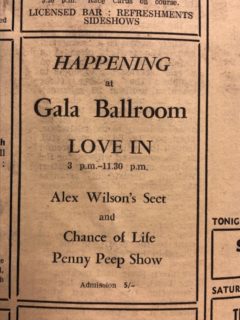
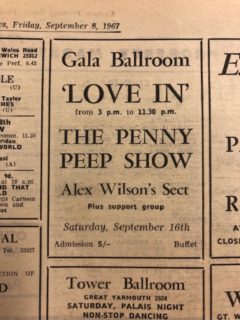
One of the first advertised shows under this name was at the Gala Ballroom in Norwich on 15 and 16 September (Friday and Saturday). On the Sunday, they travelled over to Birmingham to appear at the Swan in Yardley.
Other dates that month included a return to the Royal Ballrooms in Boscombe on Saturday, 23 September and an appearance at the Belfry in Wishaw, near Sutton Coldfield, West Midlands two days later, with The Sight & Sound.
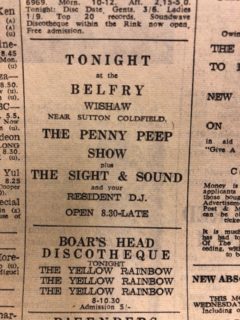
The Penny Peep Show were back in the Birmingham area early the next month for a show at the Penthouse in the city centre with New Zealand group The Human Instinct on Saturday, 7 October (they would return here on Friday, 3 November).
It was possibly this same weekend that Stevens met his future wife Beth.
“We played at Birmingham University for the Fresher’s Dance, which is where I met Beth. I definitely remember that gig. Beth lived in Hersham, near Walton-on-Thames and she used to go to Walton Hop where we played some months later [in May 1968]”.
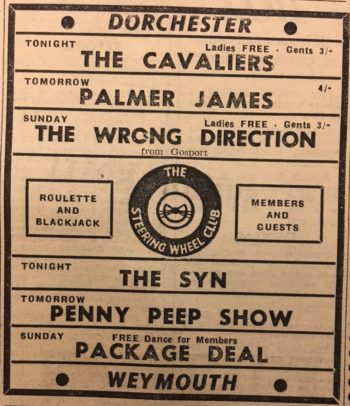
The following weekend, the musicians headed down to the southwest for a show at the Flamingo Ballroom in Penzance on Saturday, 14 October and headed home via Dorset to appear the Weymouth’s Steering Wheel on the following Saturday evening (21 October).
Throughout the next month, the band continued to crisscross the country, playing at venues like Birmingham’s Ringway Club on Saturday, 4 November; the Carnival Hall in Basingstoke, Hampshire on Thursday, 9 November; Coventry’s Tudor Club at the Mercers Arms on Sunday, 19 November; and the 76 Club in Burton-on-Trent, Staffordshire on 24 November.
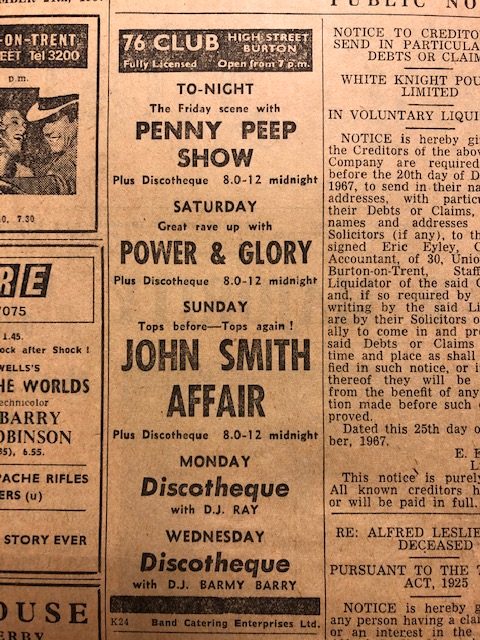
Newspaper adverts reveal that during December, The Penny Peep Show returned to play shows at Weymouth’s Steering Wheel, the Royal Ballrooms in Boscombe (returning in early January) and the Swan in Yardley, closing the year with a show at the Wellington Club in Dereham, Norfolk on Saturday, 30 December.
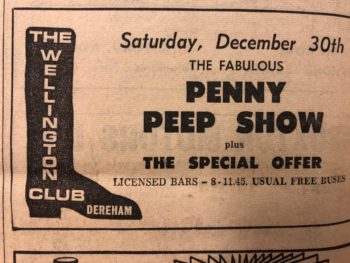
Through Pete Hockham, formerly one of Bob Gaitley’s agents at the Beat Ballad and Blues agency and now working for Brian Epstein’s NEMS agency, the band signed up with NEMS around January 1968 and gained regular work in the London area.
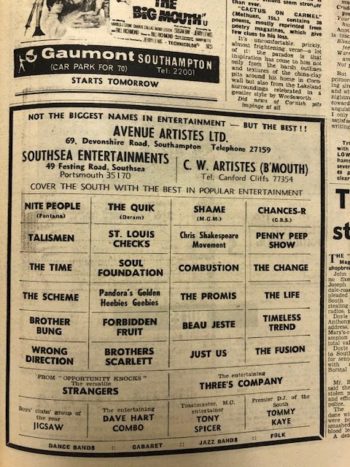
One of the group’s first London dates took place on Thursday, 8 February, opening for Brighton band The Mike Stuart Span (who shared the same agency) at the famous 100 Club in Oxford Street.
The next day, the group played at the Nottingham Boat Club. Over the next year, the musicians would regularly perform in the city and its surrounding area.
That same month, the group signed a deal with Liberty Records and got to work recording over an album’s worth of material, most of which comprised demos.
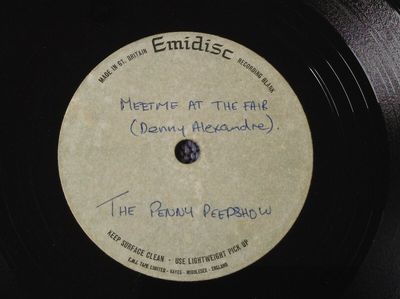
Interested listeners can hear early demos of the four tracks that made up The Penny Peeps’ two singles plus unreleased tracks online. Acetates of “Model Village”, “I See the Morning”, “Curly, The Knight of The Road” and “Meet Me at the Fair” reveal just how powerful these demo versions were.
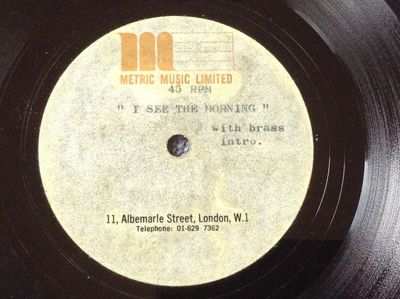
“When The Penny Peeps got the Liberty contract, I also got a song writing contract with them from Metric Music, which was on Albermarle Street at the time,” says Alexander.
“When I went to sign my contract there was also a duo who were part of band called the Idle Race. One turned out to be Jeff Lynne later of ELO fame and fortune. A third person sitting in the corner very quietly and looking very shy and school boyish turned out be Mike Batt!”
“The contract required a certain amount of songs in a certain period,” continues Alexander “and the band used to act as session men – and therefore got paid which helped when gigs were scarce. Most songs were recorded at the Marquee studio at the back of the old Marquee club in Wardour Street. I probably wrote about 15 or 16 songs.”
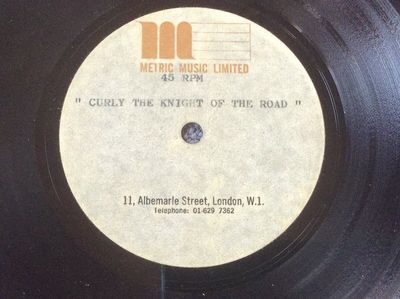
Some of these songs, such as “Helen Doesn’t Care” and “Into My Life She Came”, which features Martin Barre on flute, are gems. So is “Meet Me at The Fair”, which the group had envisaged would be coupled with Alexander’s organ and guitar driven rocker “Model Village” for the band’s debut single. Instead, Liberty chose to go with the poppy Les Reed-Barry Mason collaboration, “Little Man with a Stick”.
“I remember how pissed off we all were when Liberty insisted that ‘Little Man with a Stick’ should be the ‘A’ side as it was not us and none of us liked it,” says Stevens. “I suppose it was the usual case of the record company wanting to use their in-house song writers.”
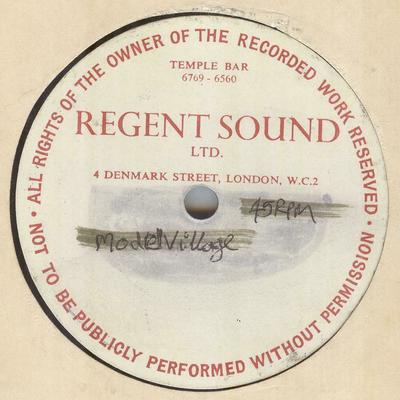
Released on 16 February, under the new name, The Penny Peeps, “Little Man with a Stick” c/w “Model Village” failed to chart, although it did gain some radio exposure. (Ed – mint copies of this single will set you back a hefty price.)
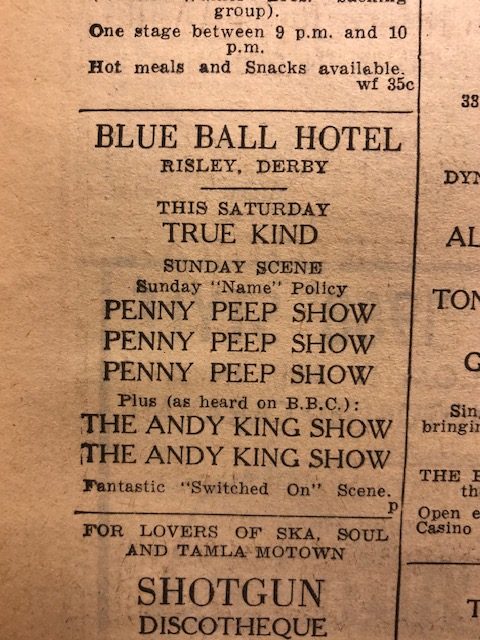
“Little Man with a Stick” received a lukewarm welcome in the music press, with NME reporting: “A new British number by Les Reed and Barry Mason. It’s good fun with a strong novelty content, but not one of the duo’s most memorable compositions. Competent performance.”
The single’s release coincided with a memorable show at the Brighton Dome Theatre on Thursday, 22 February where The Penny Peeps backed The Scaffold on a bill that also included The Bonzo Dog Doo Dah Band and also played their own set. Back in London, the group appeared at London’s Speakeasy six days later.
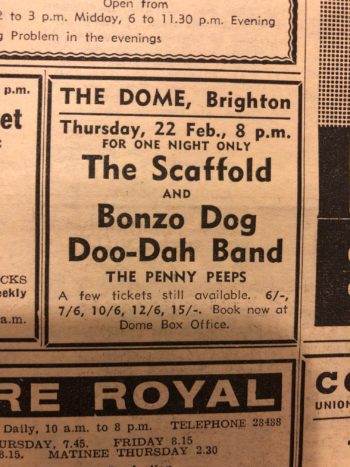
Throughout this period, the group toured extensively, and even made a brief trip to Belgium to play some dates.
“We played in Belgium for an Embassy party on-board a ship tied up at the docks,” says Stevens.
Sean Connery and Bridget Bardot were in the audience that night and Ketley thinks they may have been celebrating after wrapping up filming on the movie they were in together called Shalako.

On Friday, 8 March, The Penny Peeps returned to play a show at the Nottingham Boat Club.
A few weeks later, on Saturday, 23 March, they were back in the city to appear at the Beachcomber Club. The previous evening (billed as The Penny Peep Show), the musicians performed at the Fiesta Hall in Andover, Hampshire.
Closing the month, The Penny Peeps returned to Bournemouth for a show at the Linden Sports Club, a venue they would perform at regularly throughout the year.
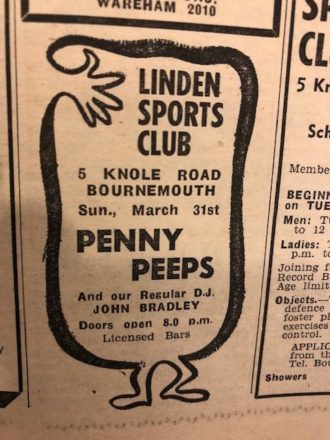
Newspaper adverts for April reveal that The Penny Peeps performed regularly along the south coast.
Besides the usual trek to Weymouth to play the Steering Wheel (Wednesday, 3 April), the band also played at the Cobweb, situated at the Marine Court in St Leonards, East Sussex. The show (on Saturday, 20 April) found the band playing on the same bill as Tony Rivers & The Castaways, soon to morph into Harmony Grass.

On Thursday, 25 April (again billed as The Penny Peep Show), the musicians played at Hatchetts Playground, a flash club on Piccadilly Circus.
With the band’s original material going down a storm on the road, the group returned to Nottingham on Friday, 3 May for another show at the Nottingham Boat Club.

Later that month (Saturday, 18 May), The Penny Peeps played at the Walton Hop, situated in the Playhouse at Walton-on-Thames, Surrey, the UK’s first discotheque.
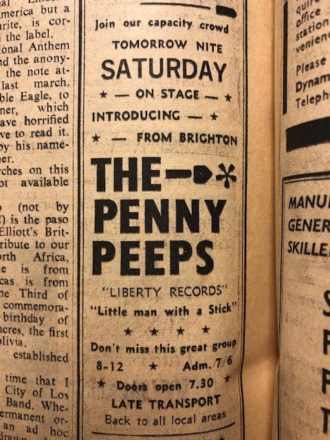
On Saturday, 15 June, The Penny Peeps returned to Nottingham for a show at the Beachcomber Club, returning home to Bognor Regis that evening to perform at the Linden Sports Club in Bournemouth the next day.
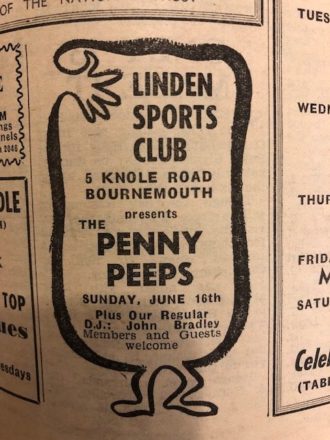
Six days later, the band’s second release Alexander’s “I See the Morning” c/w “Curly, The Knight of The Road” also failed to chart despite Tony Blackburn using the song to open his Radio 1 Breakfast show every morning for a week.
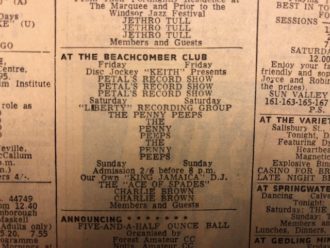
Despite plenty of work, including a return to Nottingham’s Beachcomber Club on Saturday, 13 July; Leicester Rowing Club, two Saturday’s later; and the Swan in Yardley, the West Midlands on Saturday, 3 August, the emerging blues explosion headed up by Fleetwood Mac was starting to make psychedelic rock bands redundant.

That July, Canadian group The Band’s Music from Big Pink had been given a UK release and had turned musicians’ heads, The Penny Peeps included.
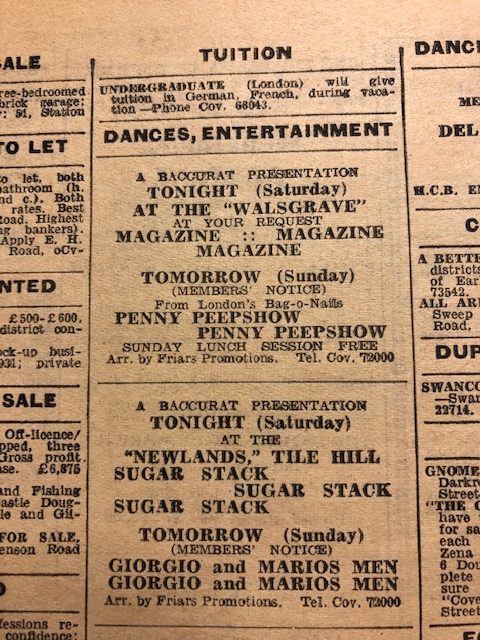
During a gig that month, possibly at the Walgrave in Coventry on Sunday, 4 August (see above) The Penny Peep Show/Penny Peeps’ current repertoire was met with an icy response and Alexander realised that drastic measures were needed.
In the interval, he suggested that the band play some blues numbers in the second set and with Ketley and Tomlinson also helping out with lead vocals, the fresh approach went down a storm.
Taking on a new name, In the Garden of Gethsemane, which was soon shortened to Gethsemane, the group began to plough a more blues-based direction.
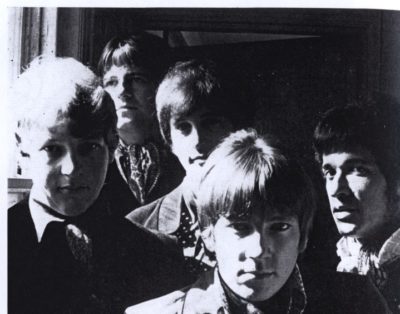
The decision to adopt a new style may also have been prompted by the Eighth National Jazz and Blues Festival held at Kempton Park racecourse in Sunbury-on-Thames on Sunday, 11 August.
Malcolm Tomlinson had attended and was blown away by Jethro Tull and its enigmatic front-man Ian Anderson whose mastery of the flute made an impression on the drummer. Both he and Martin Barre had recently started to play flute and Tomlinson came back raving about the group to Barre, urging the guitarist to check out Anderson’s inspirational group.
Around this time Denny Alexander dropped out to pursue a non-musical career.
Retiring from professional playing, he tried his hand as a trainee publican for a while but the venture didn’t last long. Back in Liverpool, he gathered together some friends who had a musical cabaret act and the sax player from The Undertakers and recorded six tracks in late 1972.
The songs: “Don’t Let It Rain (Wedding Day)”, “Crossroads of Life”, “My Last Goodbye to You”, “I’d Like to Get to Know You Girl”, “Your Alive” and “Babe I Love You” remain unreleased to this day.
The songs vary in style although some show touches of a country-rock influence. Like all of Alexander’s songs, the tracks are extremely melodic and a couple could have been huge hits in the hands of a more established artist.
With the recordings complete, Alexander turned his back on music and went into the financial services industry, retiring in the early 2000s. However, he did reunite with Bryan Stevens and Mick Ketley in the late 2000s.
Reduced to a quartet, the new musical direction that Gethsemane took gave the band an opportunity to be more creative and to stretch out during live performances.
To be continued:
Thanks to Bryan Stevens, Mike Ketley, Martin Barre, Denny Alexander, Malcolm Tomlinson, Mike Paxman, Vernon Joynson and Hugh MacLean. Thank you to Bryan Stevens and Mike Ketley for the band photos.
Copyright © Nick Warburton. All Rights Reserved. No part of this article may be reproduced or transmitted in any form or by any means, without prior permission from the author.

Some unreleased demos here often radically different to released versions
https://www.45cat.com/artist/the-penny-peeps